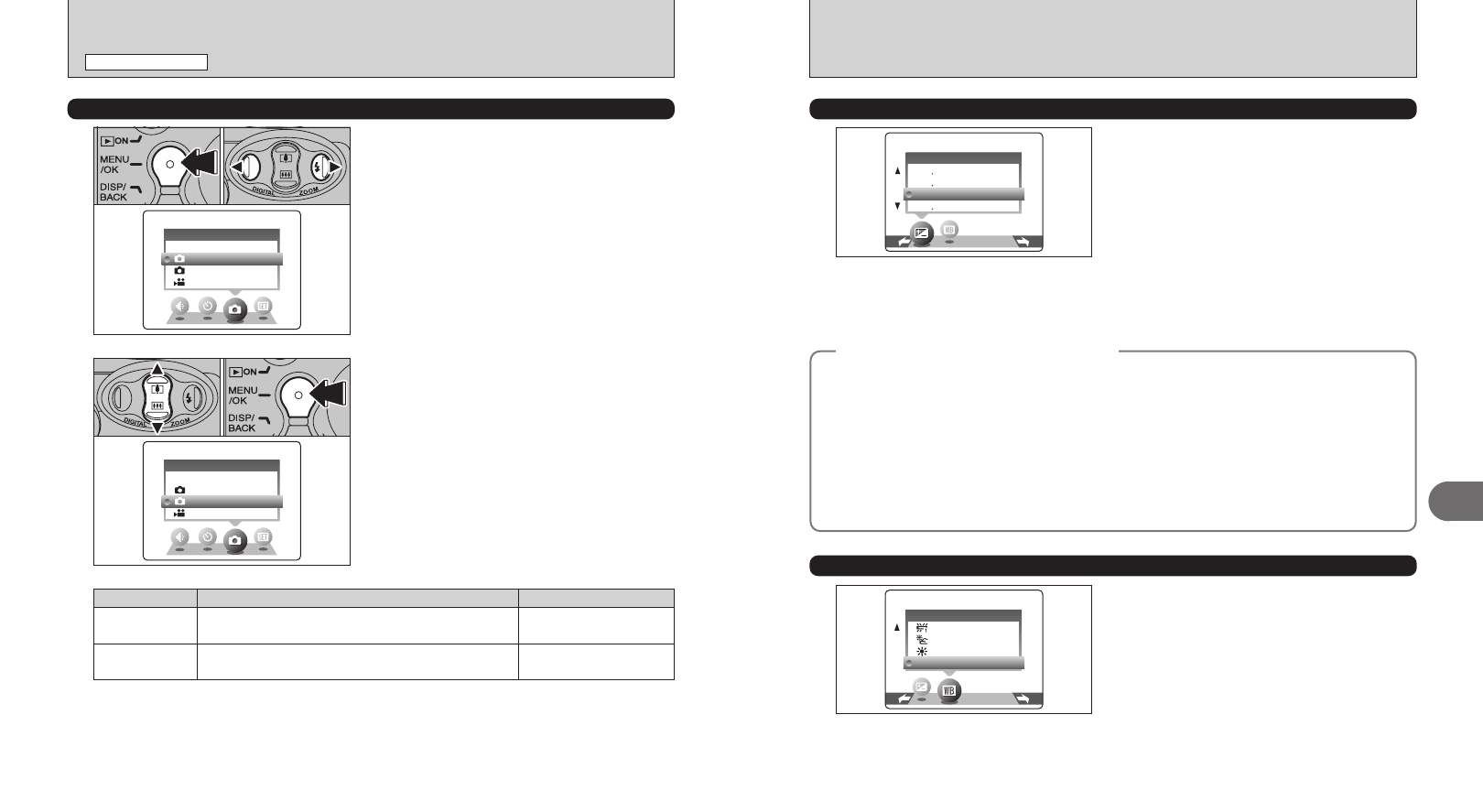
29
Advanced Features
3
28
D
EV
(
EXPOSURE COMPENSATION
)
q
SHOOTING MODE
A
WHITE BALANCE
(
SELECTING THE LIGHT SOURCE
)
Select EV in the “q MANUAL” photography mode.
Use this function for shots to get the correct
brightness (exposure), such as shots with
extremely high contrast between the subject and
the background.
hCompensation range
–2.1 EV to +1.5 EV (13 steps in 0.3 EV increments)
See P.80 for more information on EV.
●
!
Exposure compensation is disabled in the following
situations:
i When the flash is used in Auto or Red-Eye Reduction mode
i When dark scenes are shot in Forced Flash mode
Select white balance in the “q MANUAL”
photography mode.
Change the white balance setting to take a picture
with the white balance locked for the surroundings
and lighting.
In AUTO mode, the correct white balance may not
be got for subjects such as close-ups of people’s
faces and shots taken under a special light source.
Select the correct white balance for the light
source. See P.80 for more information on the white
balance.
●
!
The color tones may vary depending on the shooting
conditions (light source, etc.).
AUTO : Automatic adjustment
(shooting to show the ambience of
the light source)
6 : Shooting outdoors in fine weather
7 : Shooting in shade
9 : Shooting under “Daylight” fluorescent
lamps
0 : Shooting under “Warm White” fluorescent
lamps
- : Shooting under “Cool White” fluorescent
lamps
8 : Shooting in incandescent light
✽ When the flash fires, the white balance setting for the flash is used. Consequently, to achieve a particular effect, the
Flash mode should be set to Suppressed flash (➡P.25).
◆
To obtain the optimum brightness
◆
Adjust the exposure compensation according to the level of brightness or darkness in the image.
■ Guide to compensation
i Backlit portraits: +0.6 EV to +1.5 EV
i Very bright scenes (such as snowfields) and highly reflective subjects: +0.9 EV
i Shots made up predominantly of sky: +0.9 EV
i Spotlit subjects, particularly against dark backgrounds: –0.6 EV
i Scenes with low reflectivity, such as shots of pine trees or dark foliage: –0.6 EV
hWhen the subject appears too bright
Try a negative (–) compensation setting.
This will make the overall image darker.
hWhen the subject appears too dark
Try a positive (+) compensation setting.
This will make the overall image brighter.
PHOTOGRAPHY MENU
(
Important. Please read.
)
STILL PHOTOGRAPHY MENU
1
1Press the “MENU/OK” button to display the
menu on the LCD monitor.
2Press “d” or “c” to select “q” SHOOTING
MODE.
01 02
2
1Press “a” or “b” to select “q” SHOOTING
MODE.
2Press the “MENU/OK” button to confirm the
selection.
01 02
Shooting mode
Explanation Available flash modes
q
AUTO
This is the easiest mode for taking pictures and can be used in
a wide range of conditions.
AUTO / b / d / v
q
MANUAL
This is the mode for specifying “EV” (exposure compensation)
(➡P.29) and white balance (➡P.29) settings.
AUTO / b / d / v / c /
n


















